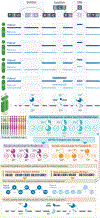The Human Pangenome Project: a global resource to map genomic diversity
- PMID: 35444317
- PMCID: PMC9402379
- DOI: 10.1038/s41586-022-04601-8
The Human Pangenome Project: a global resource to map genomic diversity
Abstract
The human reference genome is the most widely used resource in human genetics and is due for a major update. Its current structure is a linear composite of merged haplotypes from more than 20 people, with a single individual comprising most of the sequence. It contains biases and errors within a framework that does not represent global human genomic variation. A high-quality reference with global representation of common variants, including single-nucleotide variants, structural variants and functional elements, is needed. The Human Pangenome Reference Consortium aims to create a more sophisticated and complete human reference genome with a graph-based, telomere-to-telomere representation of global genomic diversity. Here we leverage innovations in technology, study design and global partnerships with the goal of constructing the highest-possible quality human pangenome reference. Our goal is to improve data representation and streamline analyses to enable routine assembly of complete diploid genomes. With attention to ethical frameworks, the human pangenome reference will contain a more accurate and diverse representation of global genomic variation, improve gene-disease association studies across populations, expand the scope of genomics research to the most repetitive and polymorphic regions of the genome, and serve as the ultimate genetic resource for future biomedical research and precision medicine.
© 2022. Springer Nature Limited.
Conflict of interest statement
Conflict of interest
None declared.
Figures



References
-
- Venter JC et al. The sequence of the human genome. Science 291, 1304–1351. (2001). - PubMed
Key References
-
-
• 61 Cheng H, Concepcion GT, Feng X, Zhang H & Li H Haplotype-resolved de novo assembly using phased assembly graphs with hifiasm. Nat Methods 18, 170–175, doi: 10.1038/s41592-020-01056-5 (2021).
o Hifiasm is a haplotype-resolved assembler specifically designed for PacBio HiFi reads, that aims to represent haplotype information in a phased assembly graph.
-
-
-
• 22 Nurk S et al. The complete sequence of a human genome. bioRxiv, 2021.2005.2026.445798, doi: 10.1101/2021.05.26.445798 (2021).
o The first complete genome assembly issued from the Telomere-to-telomere (T2T) Consortium, which closed all remaining gaps in the GRCh38 including all acrocentric short arms, segmental duplications, and human centromeric regions.
-
-
-
• 20 Miga KH et al. Telomere-to-telomere assembly of a complete human X chromosome. Nature 585, 79–84, doi: 10.1038/s41586-020-2547-7 (2020).
o The sequence of the first complete human chromosome.
-
-
-
• 64 Li H, Feng X & Chu C The design and construction of reference pangenome graphs with minigraph. Genome Biol 21, 265, doi: 10.1186/s13059-020-02168-z (2020).
o Minigraph toolkit used to efficiently construct a pangenome graph, useful for mapping and for constructing graphs encoding structural variation.
-
-
-
• 70 Paten B et al. Cactus: Algorithms for genome multiple sequence alignment. Genome Res 21, 1512–1528, doi: 10.1101/gr.123356.111 (2011).
o Cactus is a highly accurate, reference-free multiple genome alignment program useful to study general rearrangement and copy number variation.
-
Publication types
MeSH terms
Grants and funding
LinkOut - more resources
Full Text Sources
Other Literature Sources

